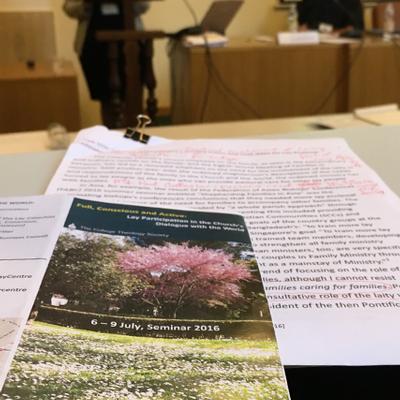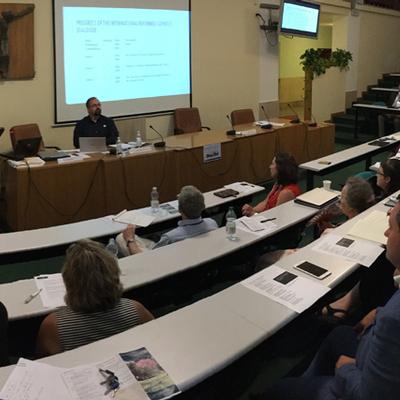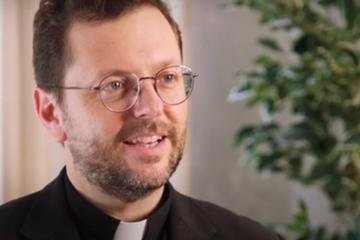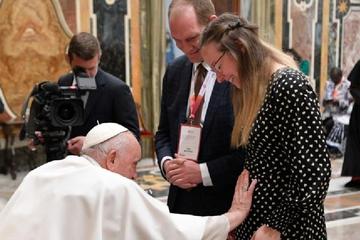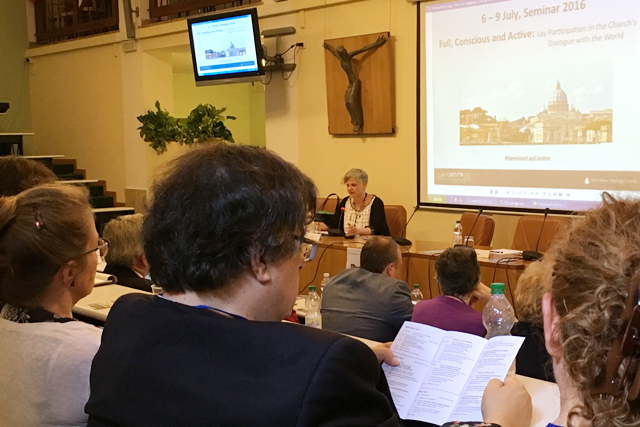
By A.J. Boyd
ROME — Taking their cue from Sacrosanctum Concilium, the first document published by the Second Vatican Council, the College Theology Society (CTS) and The Lay Centre co-sponsored an academic seminar, from 6 to 9 July, on the theme, “Full, Conscious, and Active: Lay Participation in the Church’s Dialogue with the World”.
The conference was live-tweeted, and a publication of the proceedings is expected within the year.
Archbishop Paul Gallagher, Secretary for Relations with States within the Holy See Secretariat of State, gave the keynote. He addressed the laity’s involvement in politics with the famous quote of one Msgr George Talbert, written to Cardinal Henry Manning, in reaction to Cardinal John Henry Newman’s On Consulting the Faithful, in 1859:
What is the province of the laity? To hunt, to shoot, to entertain? These matters they understand, but to meddle with ecclesiastical matters they have no right at all, and this affair of Newman is a matter purely ecclesiastical…. Dr. Newman is the most dangerous man in England, and you will see that he will make use of the laity against your Grace.
Sandra Keating (Providence College) moderated the first morning’s discussions on ecclesiology, governance and history, featuring James Keating, Michael Canaris, Lynda Robitaille, Nicholas Radermacher and Dianne Traflett.
“Among the unfinished work of the Council is the effective consultation of the faithful on doctrine and on governance,” said Keating. She also challenged the dominant narrative of the “hermeneutic of rupture,” positing that “Vatican II did not unmoor the Church from the faith. Rather, it revealed the fragility of pre-conciliar piety” as a basis for Catholic identity.
Canaris offered a different edge on popular piety as a key for understanding the “pope of the pueblo,” Pope Francis, because it “leads to what is essential, if it is lived in communion with the Church and its pastors” despite being peripheral to the core of the faith.
Pope Francis is the pope of receptivity, of popular piety, and of a pyramid [hierarchy] inverted,” he said.
Lynda Robitaille, one of the first laywomen to earn a doctorate in canon law from a Roman pontifical university, detailed the state of consultation in the Code of Canon Law and the gaps in its implementation or expectation.
“The need for transparency in consultation and [ecclesial] governance is not optional,” she said.
Nicholas Radermacher offered Mary Elizabeth Walsh (1905-1987) as an exemplar of pre-conciliar lay leadership and ministry, especially to the poor and people of color.
Similarly, Dianne Traflet presented Dorothy Day and St Edith Stein as pre-conciliar pioneers of Pope Francis’ image of the Church as a “field hospital.” She held up St Brigid of Kildare as a model of prayer and action — an image of the mercy of the Church and our participation in it.
Afternoon papers on marriage, family, and youth moderated by Lynda Robitaille (St. Mark’s College), included Aldegonde Brenninkmeijer-Werhahn, Donna Orsuto and Filipe Domingues, Karin Heller, and Joann Heaney-Hunter. Brenninkmeijer-Werhahn offered advice from 50 years of marriage, to set aside “sacred time” each week for practical communication with your spouse, putting into practice the idea that the spirituality of communion at the heart of marriage is built upon communication.
Orsuto and Domingues offered reflections on Amoris Laetitia, Pope Francis’ second apostolic exhortation, as a model for discovering God in every day life.
Karin Heller said Amoris Laetitia calls people to move beyond the previously perceived limits of theologies of relationship, however carefully. Joann Heany-Hunter called on the domestic church as the forum, however constituted, for youth to learn to live in prayer and justice.
The third day of the conference began with James Keating (Providence College) moderating contributions by Robert White, Karen Scott, William Portier, Matthew Shadle and Dan O’Brien on historical, philosophical and practical sources for understanding the laity.
White said St Gregory the Great called all the laity, not only those in religious life, to the ascetic ideal of the monk. Scott presented St Catherine of Siena as a prophet of mutuality and reciprocity in ecclesial ministry.
Bill Portier said Thomas Judge was the originator of the idea, in 1918, that “this is the hour of the laity!” That Pope Francis recently lamented the “clock has stopped” on the hour of the laity is both disheartening and encouraging, he said.
Shadle explored the idea of the lay vocation as “properly secular” by taking apart the nature of secularity, and finding the former makes sense only as a repudiation of integralism, since the world is still the realm of God’s activity.
O’Brien spoke of Catholic healthcare as a case study of lay engagement with the mission of the Church “in the world.”
William Portier (University of Dayton) led the afternoon discussions on communications and interreligious dialogue with Donald Maldari, Daniella Zsupan-Jerome, Sandra Keating and Giovanna Czander.
Donald Maldari opened with a look at the lay apostolate as ministerial participation in creation’s evolution wherein there is nothing profane about the secular order.
Daniella Zsupan-Jerome said, in today’s digital culture, having a voice that matters and the possibility of collaboration is a given; any system failing in either accessibility or transparency is inherently suspect. The danger of discouraging ecclesial as well as liturgical participation is not an inactive laity, but an exodus from the Church.
Sandra Keating said the laity are primary actors in interreligious relations, offering Abu Raita al-Tikrit, a 9th-century West Syrian theologian, as a model. She further emphasized the continuity of Nostra Aetate within the great Tradition of the Church, over against those who would see it as something entirely new and a cause for rupture.
Czander similarly emphasized the lay role in dialogue, turning to Chiara Lubich, founder of the Focolare Movement, as the model.
Robert White (Angelicum/Lay Centre) moderated a morning of discussion on media, culture and challenging paradigms of lay identity with Mary Beth Yount, Catherine Stevenson, Mike Russo, Katherie Schmidt and Peter Baltutis.
Yount began by calling attention to the lacuna of lay ecclesial ministry: though called and authorized to serve in the Church, a “secular” vocation it is not. Universally treated poorly and lower paid than their clerical counterparts, the Church needs to be more intentional in remembering the laity as “assets” in Church ministry, she said.
Stevenson presented on the lay orders, such as the Sovereign Military Order of Malta, as alternatives to parish-diocesan and movement-religious models for participation of the laity.
“Vocation sometimes emerges as an epiphany,” she said. “But sometimes it progresses as a pilgrimage, and we need room and support for both.”
Russo spoke of the challenges of social media, which allow greater polarization and the glorification of a fringe few in the contemporary dialogue on the Church. In contrast, he held up Pope Francis as a model of adaptive leadership.
Schmidt traced three stages of papal magisterial engagement with social communications, from the invention of the printing press to the digital age, ultimately bringing us beyond a producer-consumer binary.
Baltutis presented the Canadian Catholic Organization for Development and Peace, the Canadian member of Caritas Internationalis, as an example of episcopal-lay collaboration that has suffered a deterioration and retrenchment of clericalism in recent years.
A.J. Boyd (Angelicum/Lay Centre) led the final session on ecumenism, catechesis and formation, with Linda Taggart, Karen Petersen Finch, Zoe DeBlasio and Anne Jamieson.
Taggart offered a sample lesson in undergraduate pedagogy for world religions, while Petersen-Finch employed Lonergan’s writings as a method of ecumenical reception, and reception as a means of catechesis. Reception ought to begin and end with the local Eucharistic assembly as the source and summit of ecumenical dialogue, she said.
DeBlasio spoke of how successful modern church architecture as a means of encouraging lay participation in the liturgy and beyond.
Jamieson explored the ecclesial identity of the lay catechist, whose understanding of belonging influences their ability and understanding of participation.
CTS President Bill Portier closed the seminar, stating that consultation needs to be formalized in canonical structure, as does the presence and reality of lay ecclesial ministry. He urged those present to continue the good work of the Church in the meantime, stopping in at the sacramental way stations that God provides for his pilgrim people, as they follow their proper vocation, through full, conscious, and active participation in the mission of the Church.
The CTS was founded in 1954 as a professional association for lay and religious university professors of theology, and today counts 900 members, including several Lay Centre alumni and residents.
